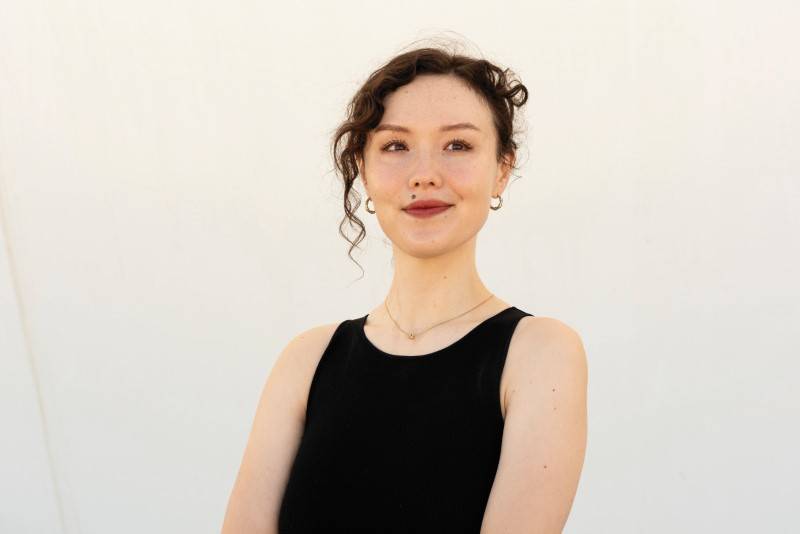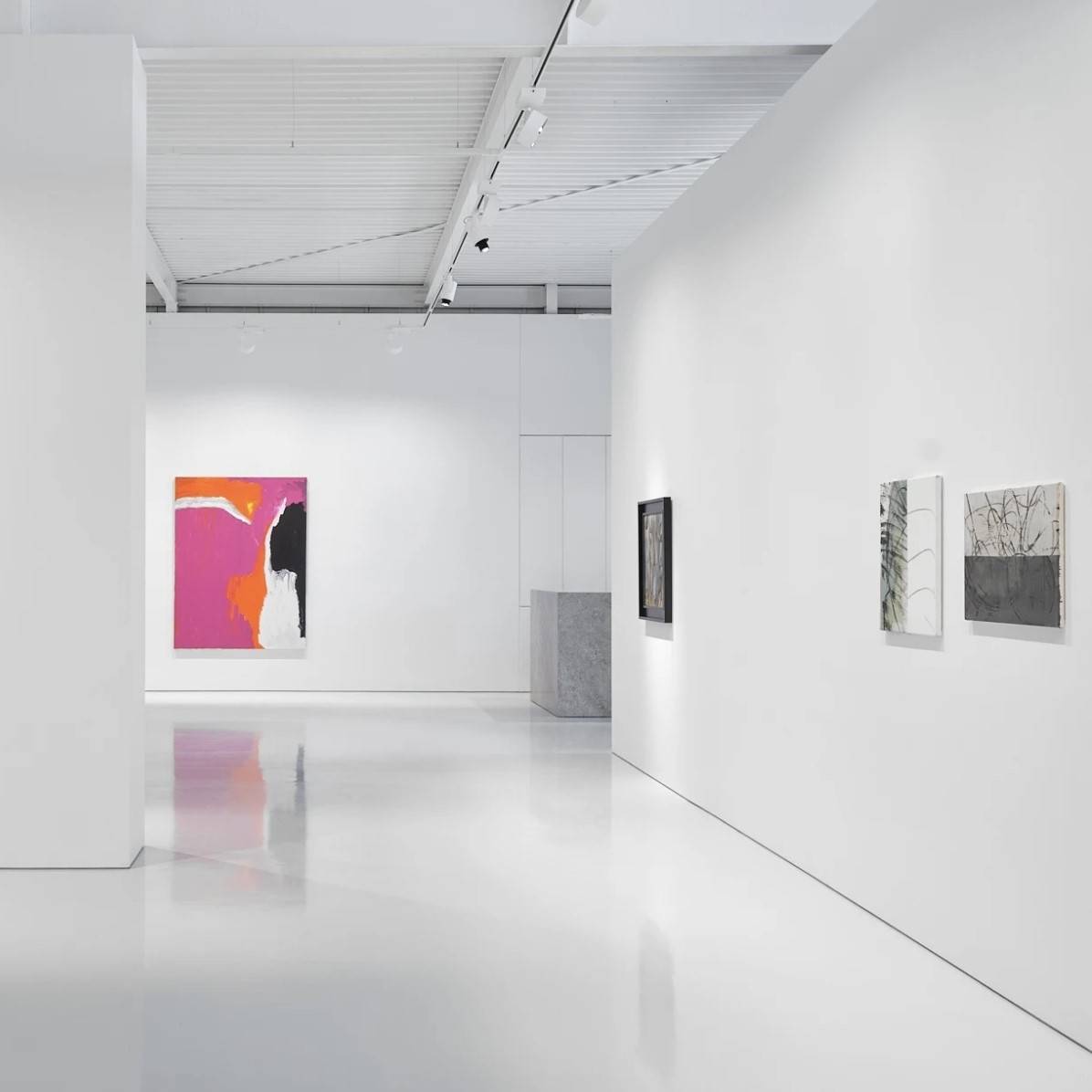Aiko Robinson: The Gentle Strokes of Passion
With thick peachy penises and erect pink nipples, the intimate works of Aiko Robinson leave us longing.
Words: Lucinda Bennett
Photography: Aaron Claringbold
The first Aiko Robinson pieces I saw were a series of lithographs she made as the inaugural artist in residence at Auckland Print Studio back in 2015. Writhing headless bodies swathed in boundless ribbons of rumpled rose, indigo and lilac grey fabric, the colours of hidden flesh; blushing hands, knees, breasts and feet spilling from twisted bedsheets, toes flexed in ecstasy. Thick peachy penises penetrating, drapes of cloth pooling like ripples in a lake, tangled with sweat and pleasure, soft puffs of pubic hair above the intricate folds of a flushed pink vulva. With their sinuous, inky black lines, I remember thinking they could be intricate tattoo designs, alongside their more obvious references to Japanese ukiyo-e art, in particular shunga, a form of erotic art prevalent throughout the Edo period (1603-1868). In later works – such as those to be shown at Gow Langsford Gallery in Tāmaki Makaurau later this year – tattoos adorn the chests, biceps and thighs of Robinson’s rapturous figures, traditional Japanese patterns (wagara) moving beyond the fabric, skin becoming another surface ripe for patterning.
Robinson is a rare artist who found success straight out of art school, having graduated from Auckland University’s Elam School of Fine Arts in 2014. Originally intending to take a working holiday in Japan, Robinson instead landed the Auckland Print Studio residency which enabled her to deepen her exploration of erotic imagery and learn different print-making techniques under the expert guidance of studio manager John Pusateri. The works she made during this residency put her on the radar of multiple gallerists from which came many opportunities to exhibit, with her work being shown consistently across Aotearoa and Japan ever since.
Well aware that her subject matter is often viewed as controversial, Robinson is frank that her interest in pornography was borne from a cynical place. When professors at Elam criticised her work for being too “safe”, “cute” and “feminine”, she decided to give them the least safe thing she could think of and turned up to her next crit with her first pornographic work. “I knew that they were going to be a bit impressed,” she laughs. “My entry into this subject matter was probably, to be honest, for all the wrong reasons… but along the way I began to do more research and realised there was a lot of potential in this subject.”
As luck would have it, her burgeoning interest in shunga coincided with the opening of the (hugely popular) British Museum exhibition, Shunga: Sex and Pleasure in Japanese Art, which ushered in a new appreciation for and understanding of the form. However, in 2017 when Robinson landed a scholarship to undertake a Masters in Printmaking at the prestigious Tokyo University of the Arts, she found most of her teachers and classmates had only recently become aware of shunga due to a Japanese exhibition that was mounted following the success of the British Museum show.
“For a long time, I don’t think Japan was very open to the idea of erotic artwork, but thankfully there was this gateway into it just before I arrived in Japan… even though the works are from there, I think it was, for a while, a tainted part of their history, something they were a bit ashamed of.” Having gone to Japan hoping to learn a lot about shunga, she was surprised to discover how little-known this area of ukiyo-e still was, probably because it had been historically viewed as something other than fine art, more akin to the “erotic manga or comic books we have these days.”
Now almost a decade into making this kind of work, Robinson is clear that her practice is primarily about pleasure. “It’s about the joy and celebration of sex and intimacy,” she says. “For historical shunga, the importance of those may have been more about fertility, the creation of life, but in all my works the figures wear condoms… I want the focus to be on pleasure.”
In her new work, Robinson has shed some of the rules that have previously guided her practice. “It was a huge moment for me when I decided to add heads into the composition,” she says. “It’s been something I’ve avoided because I never wanted to bring too much identity politics into my work, I wanted the conversation to be specifically about sex without sexualising any particular identity. But I could never avoid it completely… and because a lot of my source imagery is from pornography they’re quite idealised.”
Realising the compositional limitations of headless bodies, and the impossibility of bodies without identities, Robinson began extending her figures, allowing hints of neck and jaw, pink lips, curtains of hair. In doing so, these figures seem to be experiencing a different kind of intimacy, or perhaps it’s that our ability to perceive their relationship is heightened. Still focused on bodily pleasure, we are able to sense different kinds of connection from the barest implications: a shared gaze, a finger held to the lips, imagining the expression that might fill the face of a head thrown back in pleasure. Somehow, these faint suggestions of face make us feel even more voyeuristic than a clear view of penetration. As our eyes glide over their pale limbs splayed out on smooth silk, we witness their pleasure and wonder who they are, where they’re from, what turns them on.
JOHN PUSATERI
Founder and director, APS Editions, Auckland
“Discovering Aiko Robinson’s art at her undergraduate exhibition at the Elam School of Fine Arts, University of Auckland, was a great joy. Her large woodcuts immediately resonated with me with their nuanced and sensuously meandering lines, evoking an eroticism reminiscent of shunga prints from the Edo period. Despite the explicit content, Aiko’s work exuded a compelling allure both graphically and contextually. The work was bold, prompting me to select her for the inaugural APS Editions prize, a residency focused on stone lithography.
“Collaborating with Aiko on a series of five lithographs further underscored her exploration of sexuality and sensuality through art. While these pieces were overtly erotic, it was the quality of Aiko’s line work that continued to intrigue me. Her evolving compositions and textures add depth to the narrative, often concealing and gradually revealing passionate encounters. It is often an arched foot or tangle of fabric that feels more charged than the nudity or even moments of penetration that are depicted.
“Drawing courage from and connecting to Shunga prints, Aiko’s work delves into contemporary societal norms and attitudes toward sexuality. By exploring themes of intimacy and desire, she contributes to a broader dialogue on sexual liberation and her identity. In doing so, her art achieves an impact akin to that of the historical Shunga prints, resonating with audiences and challenging perceptions of eroticism in modern society.”
ANNA JACKSON
Director, Gow Langsford Gallery, Auckland
“Aiko Robinson is the newest artist to our stable and we have represented her only since 2023. Her upcoming exhibition will be the first solo with us having debuted in a group show with us at Sydney Contemporary in 2023 – her works were extremely popular and sold out to both local collectors and in the USA.
“Her practice is richly nuanced; I find her works both provocative and serene. There is a stillness and conceptual depth in the pairing of traditional techniques with complex themes of intimacy, consent, gender, and contemporary sexual politics. They are always beautifully rendered and immaculately presented.
“I do think there is a broad appeal for her work although, because of the sexual nature of them, this can be harder to establish with collectors. Broadly speaking they seem to appeal to a younger audience.”
This article was originally published in Art Collector issue 108, April-June 2024.









